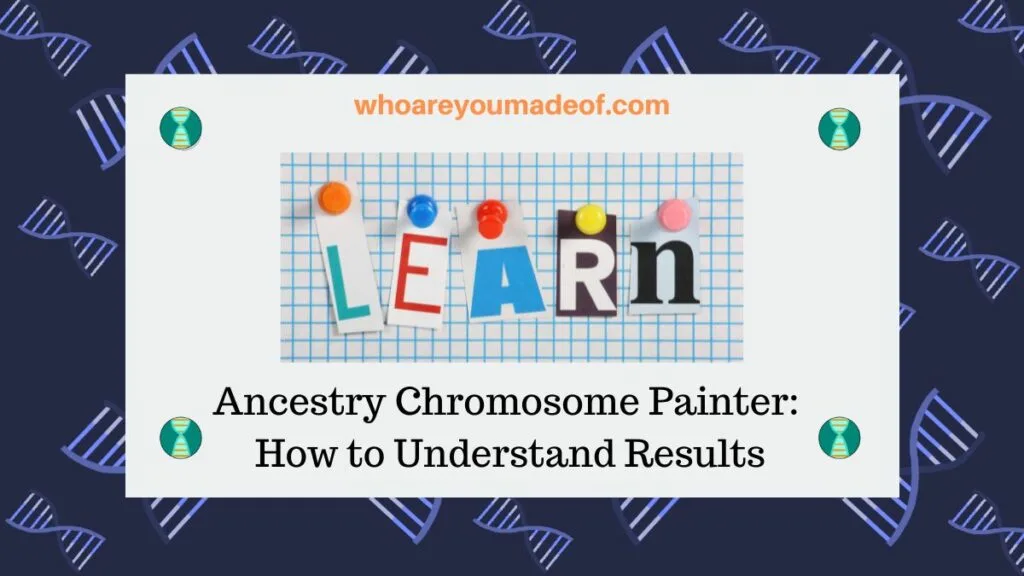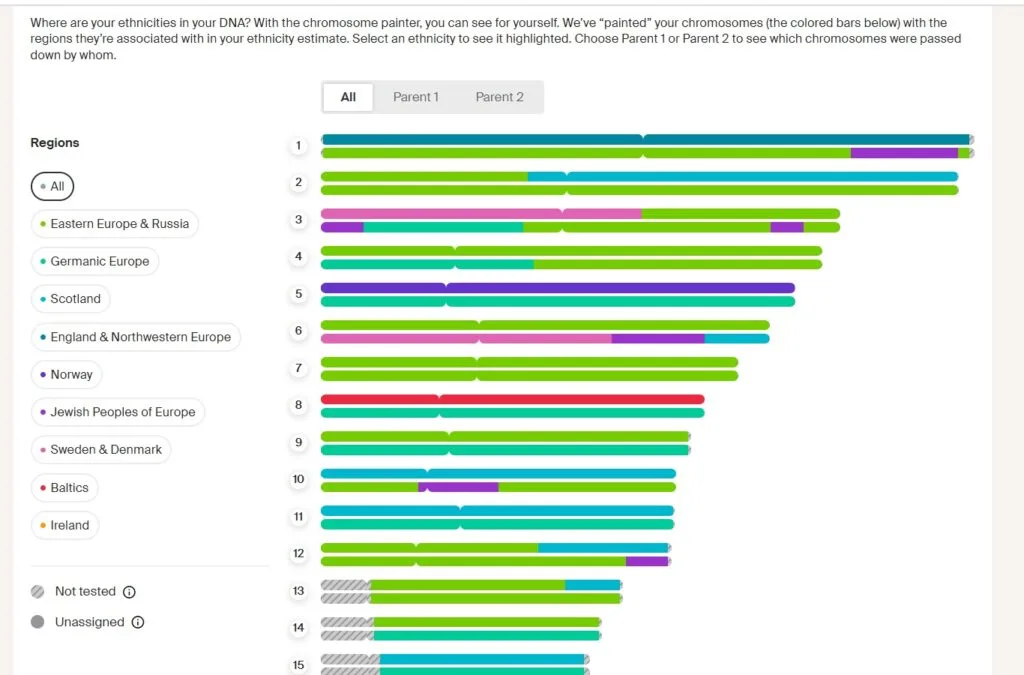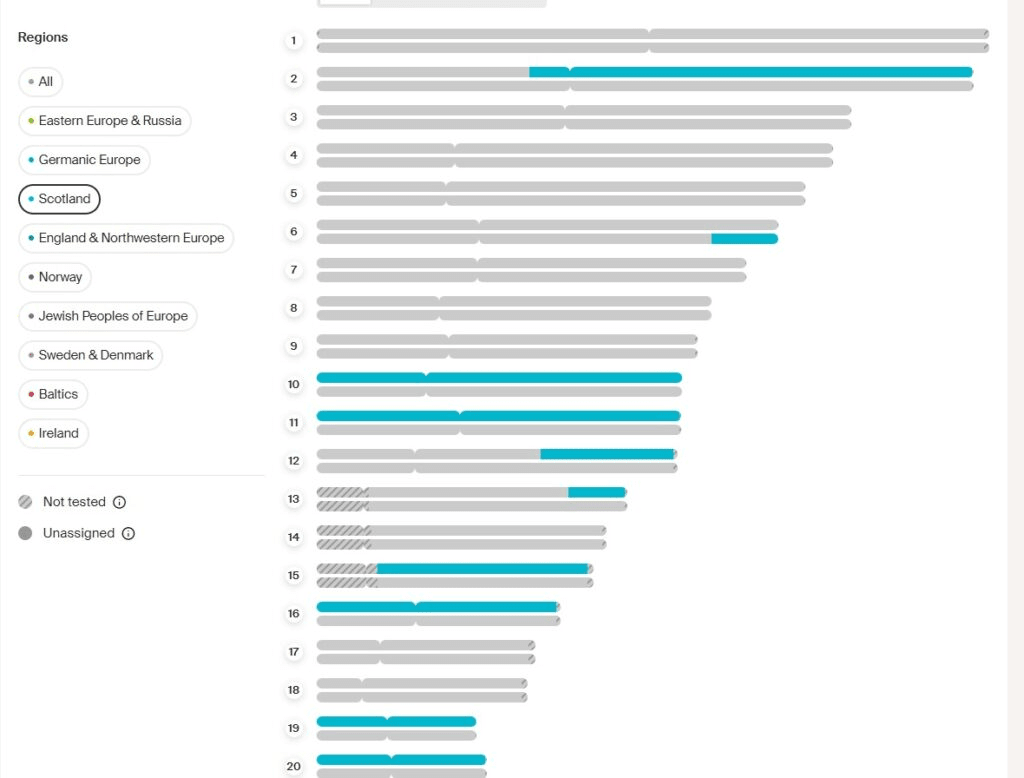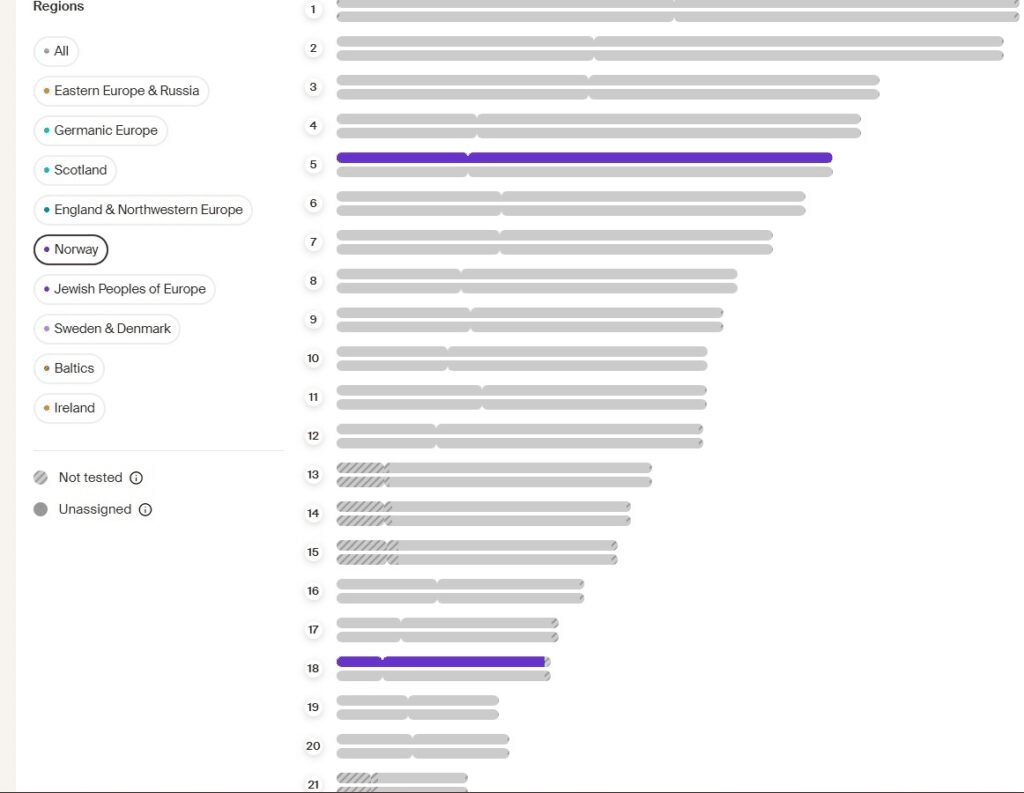Do you want to learn how to use and understand the Ancestry Chromosome Painter feature? In this post, find tips for how to get the most from this tool.

Those Ancestry users who absolutely love their results, but want a bit more detail from their ethnicity estimate will be very happy to learn how to use this feature. However, it does begin to venture into the territory of more intermediate DNA topics, which is why I decided to write a series of posts dedicated to explaining the feature and how to understand what we can learn from it.
This tool was released in the middle of 2022 and has already been improved and expanded. In addition, it is also in beta (meaning: it's still being actively tested) and may be updated and changed over time.
For example, the same technology used to develop this tool now allows us to automatically group our Ancestry DNA matches By Parent, which is one of the most exciting developments in DNA testing technology in several years.
What does the Chromosome Painter do?
The Ancestry Chromosome Painter gives us a way to explore the ethnicity regions that we inherited from our paternal and maternal sides of the family. It does this by illustrating sections of our DNA that match the regions that we see in our ethnicity estimate using a chromosome "painting" technique.
We can explore the Chromosome Painter in a few different ways, which I will explain below.
Visual display of ethnicity inheritance on each copy of your chromosomes
As I mentioned, the primary way to use this tool is for visualization of where on your chromosomes your DNA matches the different regions on your ethnicity estimate. Each region is assigned a color, and depending on your unique family history, you may see many different colors or only a few.
For this post, I am going to use my mother's results and walk through a few ways that we can use this data. The image you see here is an example from her kit that shows all segments and ethnicity regions highlighted on her chromosomes.

What we see on this image is my mother's numbered chromosomes 1-15. She, of course, has 22 numbered chromosomes, but my screen capture cut the bottoms ones off.
You see two copies of each numbered chromosome, which she inherited from her mother and father. Each copy of each chromosome has at least one colored section that corresponds to an ethnicity region shown to the left of her painted chromosomes.
For example, you may note that on Chromosome 3, the first copy of her chromosome has a large pinkish segment that corresponds to the Sweden and Denmark from her estimate.
Ancestry has reported that they only show regions on our ethnicity estimate that make up at least .5% of our DNA. This is because they are less confident about those super tiny percentages, and so they don't report them.
When there is a region of our DNA that doesn't have any color on it, it will show either "untested" or "unassigned". The unassigned regions are those very small areas where Ancestry's algorithm has not been able to determine our ethnicity at a high confidence level.
The untested regions are small areas in our DNA where, for a variety of reasons, there is no data available to display. One such reason that we might not see an untested region is because the DNA is harder to examine in certain areas of the chromosome.
Highlight sections of your chromosomes matching ethnicity regions
An additional use of the Chromosome Painter is to highlight those sections of your chromosomes that match a region that you are especially interested in learning more about. To highlight a specific region, you can click on the region on the left and it will only display those matching segments on your chromosomes.
For example, in the image below I have highlighted the "Scotland" region on my mom's results. You will note that she has several (about eight) blueish segments that match the Scotland region.

Something that you might notice from the image above is that all of the Scottish DNA segments are on the first copy of each chromosome. If you noticed this, great job!
This brings me to the next aspect of the Chromosome Painter.
Highlight chromosomes by maternal or paternal copies
One of the most exciting features of this tool is the ability to highlight only the maternal or paternal chromosomes, and then paint on the ethnicity regions that you want to see. You can select Parent 1 or Parent 2, and then paint all of the regions, or just a few.
It is easy to identify who is Parent 1 and Parent 2, and you can find strategies here: Parent 1 and Parent 2 on Ancestry DNA.
What can you learn from the Chromosome Painter?
Now that you've seen all that the Chromosome Painter can do, you might wonder how this information can actually help you learn about the ancestors on your family tree. With a little research and creativity, I believe that this tool can be very useful for genealogy research.
Many people are under the impression that ethnicity results are only for fun and not really useful for family tree research. This is far from the truth, and my hope is that after we all learn to use and understand the Chromosome Painter to its full extent, everyone will see just how useful the ethnicity data can be for tracking down our ancestors.
Estimate how far back your ancestor from that region might be
We can use the information from the Ancestry Chromosome Painter to estimate how far back our ancestor from whom we inherited a particular region might be. Ancestry has said that the longer the segment matching a region, the more recent the common ancestor.
I took a closer look at some of the regions on my mother's results, and I see that she has two sections of DNA that almost completely match the Norway region. This could indicate more recent Norwegian ancestry than our family had previously imagined.

Prior to the release of this painter tool, we only knew the percentage that matched any of the regions on our list. We couldn't visualize the size of the sections of our DNA matching these regions, and now we can.
This is especially important information to have, since we might have lots of smaller segments matching a region, or just a few long ones. It is very helpful to know whether we should be searching for many distant ancestors, or a single, more recent one.
Estimate a parent's percentage of an ethnicity region
Another really interesting use for this tool would be when more than one sibling from the same family has taken a DNA test. Since we can now see the sections of DNA matching a particular region, siblings could compare their results to find segments that have not been counted in their results.
This could help us discover how much DNA from that region our parents or other older relatives may have had. Up until now, we could only see our percentages and assume that our parents had roughly double the amount, even though we know ethnicity is not evenly passed down in DNA.
Comparing our Chromosome Painter results to those of our siblings could reveal potentially important information. I'm working on digging into some examples of this, and I'll be sure to post them here soon.
Find out the ethnicity of a specific ancestor
If you have uploaded your Ancestry DNA data to other sites, such as MyHeritage or Family Tree DNA, you will be able to have access to exactly where your DNA matches your relatives at the chromosome level. It is possible to draw some preliminary conclusions that can point your research in the right direction from this information.
This would only work if you know which side of the family your DNA match matches you on, and which parent corresponds to you (i.e. Parent 1 or Parent 2) on the Ancestry Chromosome Painter, of course.
For example, if you know that you have a paternal second cousin on a site like Gedmatch or MyHeritage that shares a long DNA segment on Chromosome 8 with you, and you can see that your paternal copy of that chromosome corresponds to a single region (i.e. the Baltic region, to stick with our example) on the Chromosome Painter, it is possible that one of your paternal great-grandparents passed that ethnicity region to you.
This could help you better focus your family tree research on that line of the family.
Discover how you might connect with DNA matches
This tool could also help you narrow down how matches on other sites might be related to you. For example, let's say you have a long section on a specific chromosome matching a single region that you know is on your paternal side of the family.
You might be able to conclude that DNA matches on other sites that you know are paternal matches and match you on that chromosome are descended from an ancestor from that region.
For example, I noticed that my mother has a long paternal segment on Chromosome 8 matching the Baltic region. If I find not-too-distant paternal matches on another site that shows details about shared DNA segments at the chromosome level, I might be able to work on a hypothesis that those matches are descended through an ancestor from that region.
Compare this data to ethnicity results from other sites
A final application for the information we learn from the Ancestry Chromosome Painter tool is to perform our own comparison between the results and what we have seen from our results from other companies that offer a similar tool. This would be available to anyone who has taken a test with Ancestry and 23andMe or Family Tree DNA.
Both of these companies offer a version of a chromosome painter, so we could either test with these companies or upload our DNA. Then, we could do a side-by-side comparison to see if the companies are finding similar regions at the same locations on our chromosomes.
If they are, we can take this as an extra nod towards the accuracy of our ethnicity estimates and as a boost to our research.
What the tool can't currently do
We can't use the Ancestry Chromosome Painter to find specific start and stop points of ethnicity segments, or sections. This type of information is available in the more advanced chromosome browsers that we can find on third-party sites like Gedmatch or from some of the other DNA testing companies.
The one other important limitation of the feature that I believe is important to mention is that we should be careful about the conclusions that we make from using this tool. This is especially true when it comes to DNA matches.
For example, our Chromosome Painter results are only visible to us and those who we have made managers of our test results via the Ancestry DNA test settings page. Some of our relatives may show us screen captures of their results or share them with us in other ways, and we may be tempted to assume that if we share the same ethnicity region with them in the same general location on a chromosome, that this region was inherited from the ancestor shared with the relative.
For example, if my cousin has a long Baltic segment on Chromosome 8, I can't automatically assume that he has this segment and I have this segment, that we both inherited these segments from our shared ancestor. We may have, but we do not have enough information about our shared DNA to make this conclusion.
In other to be sure, we would need to know that we have an identical DNA segment in that same region of Chromosome 8. We do not have this information on our Ancestry DNA results.
It is equally plausible that my hypothetical cousin with Baltic DNA inherited their Baltic DNA from an ancestor on a different line of their family tree, from someone who perhaps is not my ancestor. Alternatively, they may have inherited a Baltic DNA segment that was from our shared ancestor, but not a segment that I also inherited.
Conclusion
This Chromosome Painter tool is one of the first of what I can only hope will be many new features developed based on the technology used to determine the SideView results, which show us ethnicity region inheritance. There is a lot that we can learn from this tool, and as I discover more ways to use it, I will be sure to share them with my readers.
If you have any questions about something that you read in this post, or if you would like to share a way to use these results, I would love to hear from you in the discussion below.
Thanks for stopping by today.

Frances Stickley
Sunday 11th of February 2024
This was really helpful, thank you.
Do we yet have any idea as to how many generations back might be linked to segment length? My entire maternal strand of chromosome 1 is Norwegian but my percentage Norwegian DNA is only 6%.
Nancy
Wednesday 1st of February 2023
You said the blue was all from parent one but there’s a small bit on chromosome 6 from parent 2. I love this stuff but mistakes like this make it even more confusing. And it is pretty confusing without the mistakes.
Mercedes
Friday 3rd of February 2023
Hi Nancy, Thank you for pointing that out - I had not actually noticed it myself in my excitement about tracing my mom's father's Scottish roots. If my mom does indeed have a Scottish segment on her mother's side of the family (which is German and Polish) it could mean one of two things: the segment is small and has been misidentified as matching the Scottish region OR my grandmother had a distant ancestor from the Scotland region. Thanks for your comment! Sincerely, Mercedes
Wendy
Monday 8th of August 2022
So enjoyed the helpful article. Perhaps you might help with a confusion that has arisen looking at Chromosome 1 for my father and myself on Ancestry.
My father's chromosome 1 inheritance from his mother has France as a region. His chromosome 1 inheritance from his father has Sweden/Denmark and Finland as regions.
Here is the confusion: My chromosomal 1 inheritance from my father is identified as England and Northwestern Europe for the region.
To be sure, Ancestry recognizes that my father is genetically my father. And it recognizes that my father has approximately 13% English and Northwestern European Ethnicity in general.
How can my Chromosome 1 region, be a region that is different from his Chromosome 1 inheritance from his mother and father? Any understanding you can lend is appreciated.
Kath
Friday 29th of July 2022
You made mention that all the Sottish elements of your mother's ethnicity were on the first copy of each of her chromosomes. Do all of the first copies of a chromosome come from the one parent of our parent and the second copy come from the other parent of that parent? Is all the DNA in the first copy of my mother's chromosomes from just one of her parents and all the DNA on the second copy from the other of her parents? If so this would help us to identify whether the first copy is from the grandmother or the grandfather as most of us will be fairly familiar with our own grandparents' origins. I also wish to mention that on my Chromosome painter Sweden and Denmark is not pink but a colour in the blue green range which is very close to two other colours so distinguishing between the three is very difficult requiring constant switching between regions to make sure you are on the correct colour.
Mercedes
Sunday 31st of July 2022
Hi Kath, Thank you for your excellent question! Each person has two copies of each chromosome, and each copy comes from only one parent. For example, we have two copies of Chromosome 1, one copy from mom's DNA, and the other copy from dad's DNA. So, each copy shows DNA that each of our parents inherited from their parents. There is no mixing between copies of the same chromosome, so for example we do not see DNA from maternal grandparents on our paternal copy of the chromosome. The other detail that is important to mention is that we don't always know which copy of the chromosome is paternal or maternal. Only because Ancestry knows which copy belongs to the same parent are we able to see them "sorted" between sides like we do with the Chromosome Painter. On other sites, we would have to determine which copy of each chromosome is the paternal vs. maternal copy. I hope this helps! Sincerely, Mercedes
Toni
Sunday 24th of July 2022
ethnicity region inheritance means nothing to me. Show me which chromosomes my match and I share. THAT would be useful. Since my confirmed sister's ethnicity is not at all the same as mine, I see no useful purpose for ancestry's new and improved "tool".